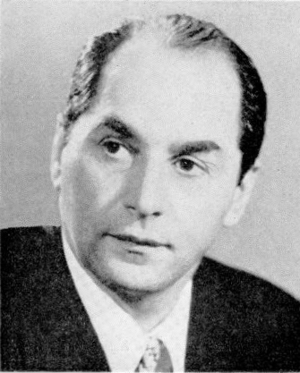Igor Moiseyev facts for kids
Igor Alexandrovich Moiseyev (born January 21, 1906 – died November 2, 2007) was a famous Soviet choreographer. A choreographer is someone who creates and arranges dances. Moiseyev was known as the best 20th-century creator of character dance. This dance style is like folk dance but adds more professional moves and theatrical flair.
Contents
Life and Career of Igor Moiseyev
Igor Moiseyev was born in Kyiv, which was then part of the Russian Empire. He was the only child of a Russian lawyer and a French-Romanian seamstress. His family lived in Paris until he was 8 years old. Because of this, he spoke fluent French throughout his life.
Moiseyev finished his training at the Bolshoi Theatre ballet school in 1924. He then danced at this famous theatre until 1939. His first dance creation for the Bolshoi was called Footballer in 1930. His last one there was Spartacus in 1954.
Creating the Moiseyev Ballet
In the early 1930s, Igor Moiseyev started staging amazing acrobatic parades on Red Square. This gave him the idea to create a special theatre for folk art. In 1936, a leader named Vyacheslav Molotov put him in charge of a new dance company. This company later became known as the Moiseyev Ballet.
Moiseyev created about 200 dances for his company. Some of these dances were quite funny, like one that showed a game of football. Another dance humorously showed guerrilla warfare. After visiting Belarus, he created a Belarusian "folk" dance called Bulba ("Potato"). Over time, this dance became a real Belarusian folk dance! Experts say Moiseyev's work was special because it perfectly mixed real folk dance with exciting theatre.
Awards and Recognition
Igor Moiseyev received many important awards during his long career. He was named People's Artist of the USSR in 1953. This is a very high honor for artists in the Soviet Union. In 1976, he became a Hero of Socialist Labor. He also won the Lenin Prize in 1967 for his dance show A Road to the Dance.
Moiseyev received several Stalin/USSR State Prizes. These were given in 1942, 1947, 1952, and 1985. He also won the Russian Federation State Prize in 1996. He was given many orders and medals from the Soviet Union, Spain, and other countries. On his 100th birthday, Moiseyev became the first Russian to receive the Order of Merit for the Fatherland, 1st class. This is the highest award a civilian can get in the Russian Federation. In 2001, he received the UNESCO Mozart Medal for his great impact on world music. He passed away in Moscow on November 2, 2007, at the age of 101.
Moiseyev's Family and Legacy
Igor Moiseyev was married at least twice. In 1940, he married a dancer named Tamara Zeifert. Their daughter, Olga, also became a dancer in the Moiseyev Ballet. His grandson, Vladimir Borisovich Moiseyev, was also a performer in the Moiseyev Ballet.
Today, the Igor Moiseyev Ballet still performs the dances created by Moiseyev. Their repertoire includes nearly 300 of his original works, starting from 1937.
Famous Dances by Igor Moiseyev
Igor Moiseyev created many different types of dances. Here are some of his well-known works:
Ballets
- Polovtsian Dances (with music by Alexander Borodin)
- At the skating-rink (with music by Johann Strauss)
- Night on Bald Mountain (with music by Modest Mussorgsky)
- Spanish ballad (with music by Pablo Luna)
- Evening in the Tavern
- Jewish suite "Family joy"
Dance Paintings
- Football
- Guerrillas
- Day on a ship (Engine room, Yablochko)
- Labour Day
- The buffoons (with music by Nikolai Rimsky-Korsakov)
and many other dances.
Honours and Awards
Igor Moiseyev received many awards from different countries and organizations. Here are some of the most notable ones:
Awards from the USSR and Russian Federation
- Hero of Socialist Labour (1976)
- Three Orders of Lenin (1958, 1976, 1985)
- Order of the October Revolution (1981)
- Order of the Red Banner of Labour, twice (1940, 1966)
- Order of the Badge of Honour (1937)
- Order of Merit for the Fatherland; 1st, 2nd, and 3rd classes (1995, 1999, 2006)
- Order of Friendship (1994)
International Awards
- Order of St. Alexander with a crown (Bulgaria, 1945)
- Officer of the Order of Culture (Hungary, 1954, 1960, 1989)
- Commander of the Order of Merit of the Republic of Hungary (1997)
- Commander of the Order of "Citizenship Award" (Spain, 1996)
- Order "Danaker" (Kyrgyzstan, 2007)
- National Order of the Cedar (Lebanon, 1956)
- Order of Sukhbaatar (Mongolia, 1976)
- Order of the Polar Star (Mongolia) (1947)
- Knight's Cross of the Order of Polonia Restituta (Poland, 1946)
- Commander of the Order of Merit of the Republic of Poland (1996)
- Officer of the Order of Culture (Romania, 1945)
- Order of Prince Yaroslav the Wise, 5th class (Ukraine, 2006)
- Order of Merit, 3rd class (Ukraine, 1999)
- Order of the White Lion, 3rd class (Czechoslovakia, 1980)
- Gold Star of the Order of Brotherhood and Unity (Yugoslavia 1946)
- Commander of the Order of Merit of the Kingdom of Spain (1996)
- UNESCO Mozart Medal (2001)
- Order of May (2004)
Prizes and Titles
- Lenin Prize (1967)
- Stalin Prizes (1942, 1947, 1952)
- USSR State Prize (1985)
- Russian Federation State Prize in Literature and Art (1996)
- People's Artist of USSR (1953)
- People's Artist of RSFSR (1944)
- People's Artist of the Moldavian SSR (1950)
- People's Artist of the Kyrgyz SSR (1976)
- Honoured Artist of the RSFSR (1942)
- People's Artist of Buryat ASSR (1940)
See also
 In Spanish: Ígor Moiséyev para niños
In Spanish: Ígor Moiséyev para niños
- List of Russian dancers



